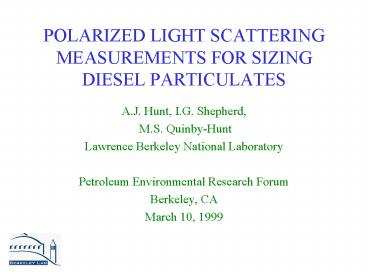POLARIZED LIGHT SCATTERING MEASUREMENTS FOR SIZING DIESEL PARTICULATES PowerPoint PPT Presentation
1 / 21
Title: POLARIZED LIGHT SCATTERING MEASUREMENTS FOR SIZING DIESEL PARTICULATES
1
POLARIZED LIGHT SCATTERING MEASUREMENTS FOR
SIZING DIESEL PARTICULATES
- A.J. Hunt, I.G. Shepherd,
- M.S. Quinby-Hunt
- Lawrence Berkeley National Laboratory
- Petroleum Environmental Research Forum
- Berkeley, CA
- March 10, 1999
2
OBJECTIVES
- Develop a method to characterize diesel exhaust
soot from polarized light scattering - Develop a real-time light scattering instrument
to measure diesel particulate size - Study the effect on particulate characteristics
of - Running conditions
- Fuel composition
- Post-combustion factors (humidity, dilution, etc.)
3
RELEVANCE TO DOE-OTT CIDI OBJECTIVES
- PM emissions are technical barriers to all but
one CIDI RD task - Accurate real time measurements of PM are
essential for - engine development and monitoring
- evaluation of aftertreatment technologies
- Emissions Compliance
- Current measurement methods are inadequate (e.g.,
smoke meter, filter methods, impactors
4
RELEVANCE TO DIESEL DEVELOPMENT, TESTING, AND USE
- Accurate real time measurements of PM are
essential for - engine development and monitoring
- evaluation of aftertreatment technologies
- Emissions Compliance
- Current measurement methods are inadequate (e.g.,
smoke meter, filter methods, impactors) or slow
(e.g. mobility analyzers)
5
APPROACH
- A existing light scattering instrument used to
measure diesel exhaust streams in situ - angle-dependent scattering intensity
- angle-dependent polarization transformations
- determine size distribution and optical
properties (n, k) (refractive and absorptive)
properties of soot by comparing experimental data
with modeled scattering - Model soot scattering as
- spheres - Mie scattering theory to fit data
- agglomerates -represent clusters as coupled
dipoles
6
Polarized Light Scattering
Scatterer, represented by Mueller
matrix,
M
Scattering Angle
q
I
Incident beam
Scattered Beam
Total Intensity
I
Q
0,90 Polarization
4 x 4 Mueller Matrix
U
45
V
Circular Polarization
7
Mueller Matrix Formalism
Stokes Vector - describes polarized light
All elements except S11 normalized by S11
8
PROJECT ACCOMPLISHMENTS
- Characterized Diesel Exhaust Particulates
- Size
- Morphology
- Optical Properties
- Background for Scatterometer Development
- Performed complete scattering measurements on
Diesel soot - Modeled scattering from loose aggregates of
primary soot spherules by Mie and coupled
dipole approaches - Identified light scattering/polarization
signatures - Designed built and tested scatterometer to
measure particle size in real time
9
Scattering Results for Two EnginesCummins B5.9
175 MAN turbo-diesel and Acme Motori - ADX 300
10
Time Response(Acme Motori - ADX 300 Diesel)
11
INTERPRETING SCATTERING DATA
- Mie scattering theory - spherical particles
- Calculates angle dependent polarized scattering
given size and optical properties of particles - Levenburg-Marquardt optimization
- Matches observed scattering with Mie calculations
varying - Log normal, Gaussian, power law distributions
- Real and imaginary indices of refraction
- Fits four matrix elements simultaneously
- Determines particle size distribution and their
complex refractive index (composition)
12
Comparison Mie Theory Experiment(Small Diesel)
0.3
Full Load
0.2
S
/S
0.1
34
11
0.0
Rayleigh
No Load
-0.1
13
Particle Size Distribution from Mie FittingAcme
Motori -ADX 300
14
Number and Mass based Size Distributions, Cummins
Diesel
15
Effects of Oxygenated FuelPreliminary Results
16
DIESEL PARTICLE SCATTEROMETER(DPS)
- Three simultaneous matrix elements sufficient
- 0f, 1f, 2f with single detection polarization
- Laser Wavelength (450 - 900 nm)
- Detector system design
- Number - 12
- Type - compact programmable photomultiplier
- Placement - 20o intervals
- Multiplexed into 16 bit A/D converter
- Software implementation of lock-in detection
- Time response (1 -10 Hz)
17
DPS DESIGN
Detectors (12)
Detection volume
Polarizer
Baffle
Laser
Base plate optical bench
Polarization modulator
18
Fractal-Like Soot Particle(if S22 ¹ 1 use
correction or coupled dipole calculation)
19
MODELING OF DIESEL SOOT PARTICLES AND SCATTERING
- Particle generated by random walk procedure
- Size (characterized by radius of gyration) is
specified by number of primary soot particles - Fractal dimension calculated (compactness)
- Coupled dipole calculation in parallel on Cray
T3E (using up to 512 processors) - Sizing by Levenburg-Marquardt optimization
technique using look-up tables
20
COLLABORATIONS
- Joint development project with ORNL (Engineering
Technology Division) - Combined measurement program with UCB Engine
Laboratory (Prof. Dibble) - Software development with Prof. Patricia Hull of
Tennessee state University - Working with researchers in the environmental
program at LBNL on diesel particulate
characterization
21
Future Plans
- Complete calibration of 2 scatterometers for
particle size measurements at 1-10 Hz rates (ORNL
LBNL) - Compare scatterometer results with Scanning
Mobility Particle Sizer and Electrical Aerosol
Analyzer (gt50nm) - Characterize exhaust from several fuels in OAAT
fuel matrix - Explore shorter wavelengths for enhanced
sensitivity - Continue coupled-dipole modeling for sizing
non-spherical diesel particles with the
scatterometer - Evaluate commercial potential of scatterometer

